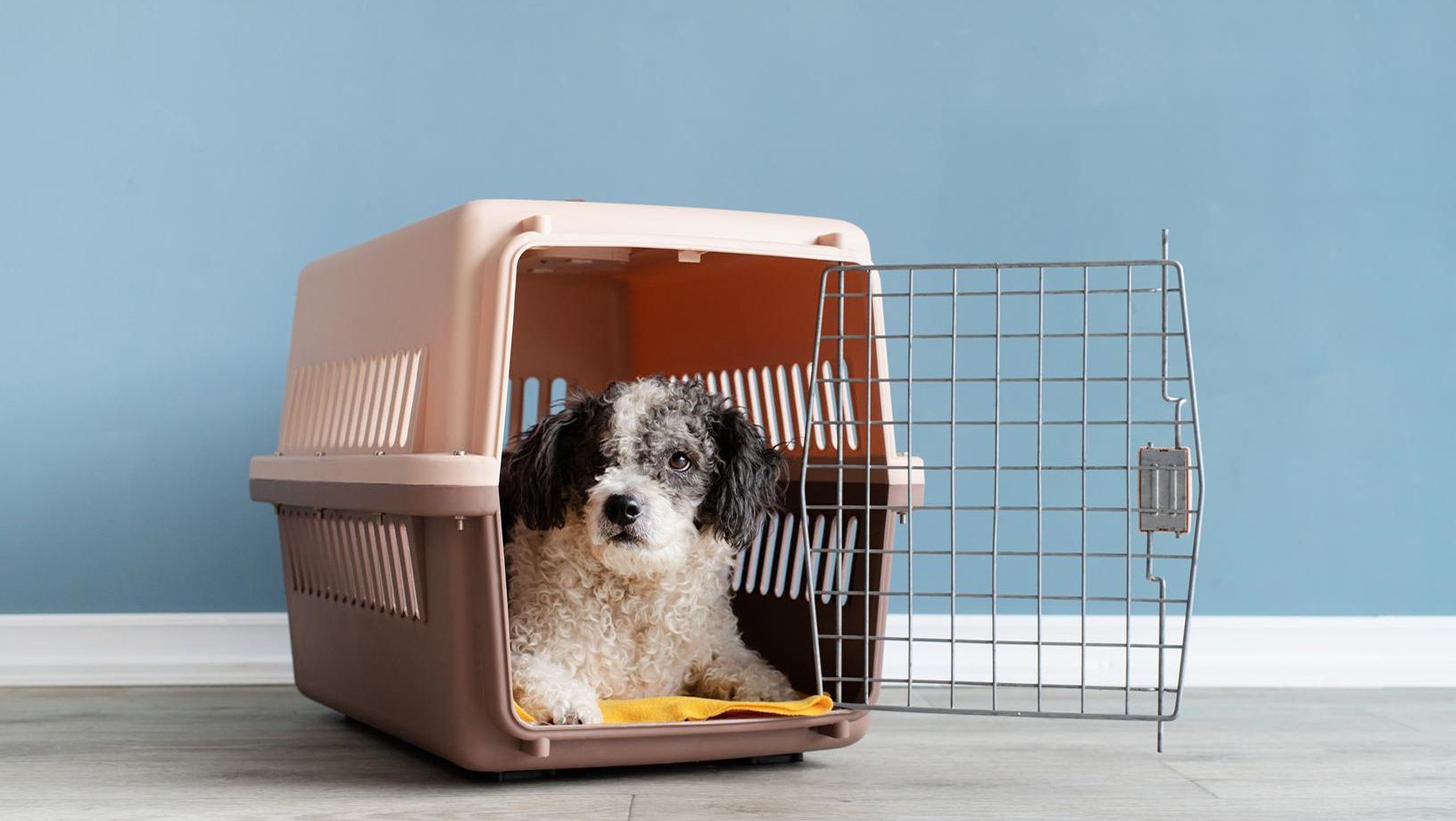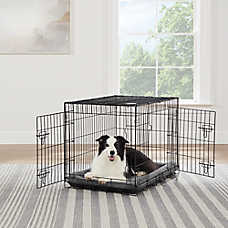How and Why to Use a Puppy Crate

In this Article
Bringing home a new puppy is one of life’s most exciting moments! As you introduce your dog to its new home and family, a puppy crate can help to make the transition easier. Crates provide a safe and secure space for your puppy to rest, sleep and learn new behaviors. From helping with potty training and preventing destructive behavior to giving your dog a sense of security, puppy crates offer lots of benefits that help to make the first few months of this new relationship happy and safe.
Here's an introduction to using puppy crates, with suggestions for choosing the right crate and introducing them to your new furry family member.
What is a puppy crate?
A puppy crate is an enclosed space designed to mimic a den. Crates help satisfy your dog’s natural instinct to seek out small, enclosed spaces where they feel safe. Typically made of wire, plastic or fabric, crates are available in various sizes and include features like removable trays for easy cleaning, collapsible frames for portability and different types of doors for easy access.
The benefits of using a public crate
Puppy crates offer lots of benefits for both you and your dog.
- Help with house training: Crates are invaluable during puppy potty training because puppies naturally avoid going to the bathroom in their sleeping area. Confining your pup to a crate for short periods trains them to wait until they are outside to relieve themselves. Crates also help prevent accidents from occurring at night or when your pup is unsupervised.
- Comfort and security: A crate gives your dog a safe space of its own where they can relax and sleep undisturbed. Crates can also help establish a sleeping routine, which is crucial for your pup’s development. A crate becomes a predictable part of the day, signaling when it’s time to rest and helping to prevent overstimulation.
- A safe space: Puppy crates are a safe place where your puppy can rest without getting in to trouble or engaging in dangerous behavior like chewing furniture, electrical cords or other hazardous items. When your dog is stressed by situations like thunderstorms, a crate offers a safe and secure space that helps your pup feel protected.
- Convenient pet travel: When you’re traveling by car or plane, a crate keeps your puppy secure and reduces the risk of injury or escape. Crates also provide a familiar and comfortable space that reduces the stress of being in unfamiliar environments.
Types of puppy crates
Puppy crates are usually made from wire, plastic or fabric.
- Wire crates offer excellent ventilation and allow your puppy to see their surroundings, which can make them feel more comfortable. Many wire crates come with dividers that allow the crate to adjust as your puppy grows. Removable trays at the bottom of a wire crate make cleaning easier.
- Plastic crates offer a more enclosed space, which may provide extra security for puppies who are shy, nervous or prefer a den-like environment. With better insulation, plastic crates may be a good choice in cooler climates. They are lightweight as well, making them particularly popular for travel.
- Fabric crates are made with a light weight frame covered in soft materials, making them easy to transport. While these crates are ideal for travel and temporary use, they may not be durable enough for puppies that are prone to chewing and scratching. This option is best suited for puppies that are already crate-trained and less likely to chew and scratch the fabric.
How to choose the right crate
Choosing the right dog crate for your puppy comes down to size, preference of material and ease of cleaning.
- Right-sizing your puppy crate: The crate should be large enough for your pup to stand up, turn around and lie down comfortably. However, if the crate is too large, your pup may decide to use one end of the crate as a bathroom! Choosing a crate with a removable divider is a great way to maintain a consistent and comfortable space throughout your puppy’s growth stages.
- Choosing the right material: Durability and portability will likely influence your choice of material. If your puppy is a chewer or scratcher, a wire or plastic crate will be more suitable than a fabric one. However, if you travel frequently, a lightweight, collapsible dog crate may be more convenient.
- Making cleaning easy: Crates with removable trays at the bottom make it easy to clean up accidents or spills. This is especially important during the housetraining phase. Crates with machine-washable covers or removable components are much easier and faster to clean.
How to crate train a puppy
Following these steps is the best way to successfully introduce your puppy to their new crate.
- Make it comfortable: The crate should be a comfortable place where your puppy enjoys spending time. Adding soft bedding, a favorite toy and a piece of clothing with your scent can make the crate more inviting.
- Introduce the crate gradually: Begin by allowing your pup to explore the crate on its own – leave the door open and place treats, toys and a comfortable blanket inside to encourage your pup to enter the crate voluntarily.
- Offer rewards and praise: Whenever your puppy visits the crate, reward them with treats and praise to reinforce the idea that the crate is a safe and fun place. Avoid forcing your puppy to enter, as that can create negative associations.
- Start with short sessions: Once your puppy is comfortable in the crate, start by closing the door just a few minutes at a time, increasing the duration as they become comfortable. Stay nearby during these initial sessions to reassure your pup and help them feel secure.
- Keep things consistent: Use the crate for short periods throughout the day at consistent times. This regularity will help your puppy think of the crate as part of your daily routine, making it easier for them to accept longer periods of confinement when needed.
- Incorporate the crate into daily routines: Encourage your puppy to nap in the crate during the day and to sleep there at night. This establishes the crate as a normal part of the day and reinforces the idea that it’s a safe place to rest. · Refrain from feeding your pet in the crate: Avoid feeding your dog in their crate. Emulating the security of den, dogs should not eat, drink or relieve themselves in a crate. Using a treat initially is fine, but mealtime should be done elsewhere.
FAQs
Is it OK to keep a puppy in a crate all day?
No, keeping a puppy in a crate all day is not a good idea. Puppies need to exercise, play, interact with people and go outside to go to the bathroom. Being in a crate too long can make them uncomfortable, bored and anxious, which can lead to behavior problems.
How long can a puppy stay in a crate?
How long a puppy can stay in a crate depends on their age. Very young puppies (8-10 weeks old) should only be in a crate for 1-2 hours at a time. Older puppies (3-6 months old) can stay in the crate for up to 3-4 hours. Even when they’re older, it’s best not to leave them in the crate for more than 6 hours during the day without a break.
Should I crate my puppy at night?
Yes, crating your puppy at night is a good idea because it gets them used to a regular sleep schedule and helps with potty training. The crate gives them a safe place to sleep, and it teaches them to wait until morning to go to the bathroom, which can prevent accidents.
What is a puppy crate vs. a puppy pen, cage or kennel?
A puppy crate is a small, enclosed space designed for dog training, sleeping, and confinement that> provides a safe and comfortable area for your puppy. A puppy cage is similar but typically larger and made of metal bars, offering more visibility and ventilation. It’s often used for temporary confinement. A puppy playpen is an open, larger area for safe play and exercise, while a puppy kennel can refer to either a portable enclosure for travel or a larger outdoor structure for long-term housing.
Need other supplies while you’re shopping for dog training products? PetSmart also carries dog food, dog beds, dog treats, leashes & harnesses, flea & tick meds and more.
PetSmart also offers services such as dog grooming services, expert dog training, safe and comfortable PetsHotel stays, and Doggie Day Camp for your pup to play and socialize. Services are available in select locations—check your local PetSmart to see what’s offered near you.
PetSmart offers convenient shopping with Curbside Pickup or in-store pickup. Need something today? We have select items available for Same-Day Delivery in most areas powered by DoorDash.
For items you purchase frequently, PetSmart has Autoship that automatically delivers the items you want to your door as often as you’d like. Check the website to see which items are eligible.
Information in this article is not intended to diagnose, treat or cure your pet and is not a substitute for veterinary care provided by a licensed veterinarian. For any medical or health-related advice concerning the care and treatment of your pet, contact your veterinarian.



